The Myotonic Dystrophy Treatment Market is estimated to be valued at USD 1.1 billion in 2025 and is projected to reach USD 3.5 billion by 2035, registering a compound annual growth rate (CAGR) of 12.3% over the forecast period.
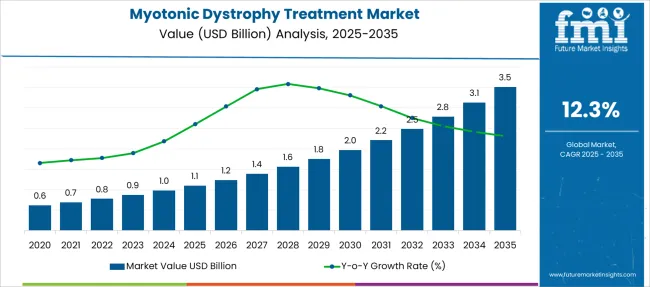
| Metric | Value |
|---|---|
| Myotonic Dystrophy Treatment Market Estimated Value in (2025 E) | USD 1.1 billion |
| Myotonic Dystrophy Treatment Market Forecast Value in (2035 F) | USD 3.5 billion |
| Forecast CAGR (2025 to 2035) | 12.3% |
The Myotonic Dystrophy Treatment market is evolving rapidly as therapeutic innovation and diagnostic awareness increase across global healthcare ecosystems. This market is being driven by advancements in molecular biology, increased research funding for rare neuromuscular disorders, and rising clinical trial activity from pharmaceutical developers. Annual reports and investor updates from biotech companies have highlighted the expansion of early-phase pipelines and orphan drug designations, supporting regulatory acceleration.
Public health awareness and advocacy by rare disease organizations are further propelling demand for novel treatments, especially in high-income economies. The future outlook remains optimistic as biomarker-driven trials and precision medicine strategies continue to emerge.
Medical journals have documented that the integration of genomics and patient registries has enabled better identification of disease subtypes, improving treatment matching and outcomes These drivers are expected to support continued investment, innovation, and adoption of emerging therapeutic approaches, resulting in a progressively more structured and accessible treatment landscape for Myotonic Dystrophy patients worldwide.
The market is segmented by Therapeutics Class and Distribution Channel and region. By Therapeutics Class, the market is divided into Molecular-based Therapies and Steroid Therapy. In terms of Distribution Channel, the market is classified into Hospital Pharmacies, Drug Stores and Retail Pharmacies, and Online Pharmacies. Regionally, the market is classified into North America, Latin America, Western Europe, Eastern Europe, Balkan & Baltic Countries, Russia & Belarus, Central Asia, East Asia, South Asia & Pacific, and the Middle East & Africa.
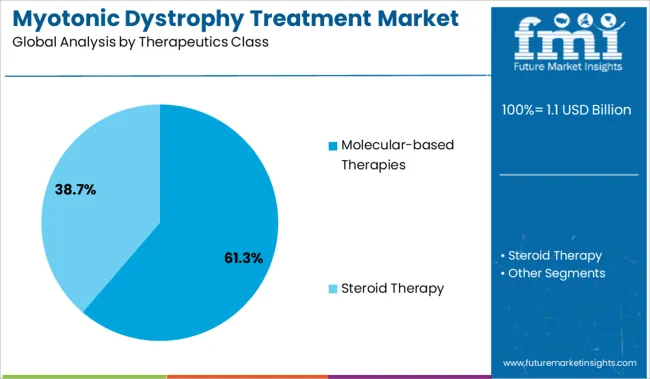
The molecular-based therapies segment is projected to hold 61.3% of the Myotonic Dystrophy Treatment market revenue share in 2025, establishing it as the leading therapeutic class. This dominance is being attributed to the increasing focus on gene-targeted interventions and antisense oligonucleotide platforms that offer disease-modifying potential.
It has been observed in clinical research publications and company press releases that molecular-based approaches are addressing the root cause of the disorder by modulating gene expression or correcting underlying RNA toxicity. The segment’s momentum has been further driven by supportive regulatory pathways and accelerated approvals for rare disease therapeutics, encouraging investment in long-term solutions rather than symptom management.
Additionally, hospital-based clinical trial infrastructure and advancements in delivery mechanisms have improved treatment outcomes and patient accessibility These innovations have enhanced both therapeutic efficacy and physician confidence in prescribing molecular therapies, leading to broader market penetration and positioning the segment as a key growth driver within the Myotonic Dystrophy Treatment landscape.
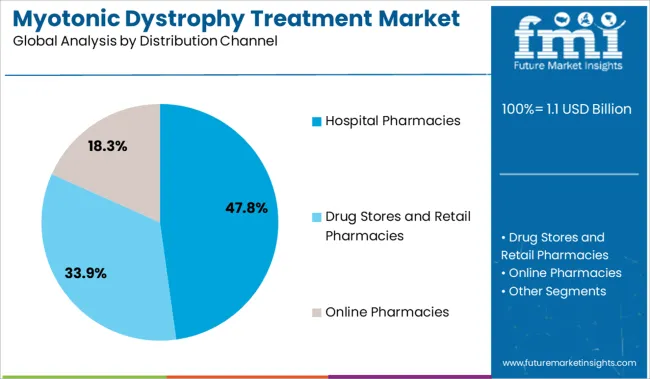
The hospital pharmacies segment is expected to account for 47.8% of the Myotonic Dystrophy Treatment market revenue share in 2025, making it the dominant distribution channel. This segment's strength is being supported by the centralized nature of rare disease treatment, where specialist oversight, infusion-based care, and complex patient management are typically coordinated in hospital environments.
Hospital settings have been identified as critical hubs for the administration of novel and often high-cost therapeutics, as outlined in institutional practice reports and pharmaceutical distribution updates. It has also been noted that cold chain logistics, reimbursement processing, and safety monitoring are more efficiently managed in hospital pharmacies, ensuring compliance with regulatory protocols.
Furthermore, close coordination between hospital pharmacies and neuromuscular clinics facilitates better tracking of outcomes and patient adherence, particularly in long-duration treatment cycles These structural and operational efficiencies are reinforcing the hospital pharmacies segment’s position as the preferred channel for the delivery of advanced therapeutics for Myotonic Dystrophy.
The global demand for Myotonic Dystrophy Treatment is projected to increase at a CAGR of 12.3% during the forecast period between 2025 and 2035, reaching a total of USD 2,789.35 Million in 2035, according to a report from Future Market Insights (FMI). From 2020 to 2025, sales witnessed significant growth, registering a CAGR of 5.6%.
According to Future Market Insights, a market research and competitive intelligence provider, the Myotonic Dystrophy Treatment Market was valued at USD 1.1 Million in 2025.
Compared to several other products of myotonic dystrophy, corticosteroids are possibly to emerge as the top-selling products during the analysis period. By 2035 end, corticosteroids are expected to exceed USD 9,000 million in revenue. Numerous scientific research has found that compared to numerous products to treat myotonic dystrophy, corticosteroids help to improve muscle strength for up to two to five years, however, the long-term benefit of corticosteroids is yet a vague concept.
Additionally, nowadays, more clinical trials are being conducted to assess potential treatments for myotonic dystrophy. The only approved pharmacological therapy for the management of myotonic dystrophy is an anti-inflammatory regimen based on corticosteroids. In recent times, there has been a huge increase in the discovery and development of pharmaceutical drugs. Approximately all major companies are now focusing on Research and Development, possibly leaving a significant impact on the market in the upcoming years.
Rising Incidence of Muscular Dystrophies to Accelerate the Market Growth
As per the Karger Journal in 2014, the global prevalence of muscular dystrophies accounted between 19.8 and 25.1 per 100,000 people every year with myotonic dystrophy (0.5-18.1 per 100,000), myotonic dystrophy (1.7-4.2) and facioscapulohumeral muscular dystrophy (3.2-4.6 per 100,000) to be the most common types of disorders.
The initial research phase of the therapies and ongoing clinical trials for the development of innovative products are expected to drive the global muscular dystrophy treatment market. In addition, specific guidance for drug development for muscular dystrophy drugs published by the USA FDA in 2020, is expected to accelerate new drug development for the treatment of the disorder.
The emergence of disease-modifying therapies as a replacement for the unmet medical needs of patients, who are not amenable to mutation-specific drugs is expected to accelerate the growth of the myotonic dystrophy treatment market during the analysis period.
Availability of Potential Pipeline Candidates to Fuel the Market Growth
The advent of drugs for the treatment of Myotonic Dystrophy is on the new horizon, which is a major factor that is expected to escalate the market growth over the forecast period. Other factors such as the growing target population, emergence of mutation-specific therapies, and favorable government initiatives are anticipated to boost the revenue share of the myotonic dystrophy market during the analysis period.
Additionally, a surge in the prevalence of myotonic dystrophy is another major factor that is considered to fuel the demand of the market. This, in turn, is propelling the launch of newly formulated pipeline drugs required for the treatment of serious patients. Further, many potential candidates are in their final stages of development and are expected to boost the market growth over the forecast period.
No Cure for the Progressive Disorder to Restrain the Market Growth
One of the major factors that are expected to hamper the growth of the myotonic dystrophy market includes the fact that myotonic dystrophy is a progressive disorder, which means that the severity of the disease increases over time. Thus, early interventions in the myotonic muscular dystrophy market, such as those that are used to treat other forms of muscular dystrophy, are not normally effective in treating myotonic dystrophy patients.
Additionally, since myotonic dystrophy is a genetic condition, there is no known cure and no trustworthy way to slow or stop the progression of the disease. Moreover, the presence of alternative herbal therapies is another factor that is likely to impede market growth during the forecast period.
High Cost Associated with Myotonic Dystrophy Drugs & Lack of Awareness to Limit the Market Growth
Factors such as the huge expenditure associated with myotonic dystrophy agents, as well as the huge drug development and associated processes are anticipated to create hindrances to the growth of the myotonic dystrophy treatment market over the analysis period.
In addition, the lack of awareness about the diseased condition, unavailability of several awareness programs, adverse effects related to the drugs, and strict regulatory frameworks are some other factors that are projected to limit the market growth in the forthcoming years.
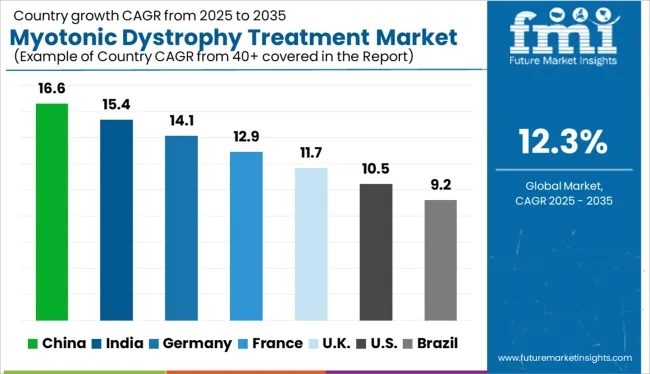
The surge in Patients Suffering from Myotonic Dystrophy in the Region to Fuel the Market Growth
The Myotonic Dystrophy Treatment Market in North America is expected to accumulate the highest market share of 48% in 2025.
As per the Centers for Disease Control and Prevention estimates in 2007, 349 out of 2.37 million males aged 5 to 24 years were reported to have muscular dystrophy in the US. North America is expected to dominate the global myotonic dystrophy treatment market, attributed to factors including the absence of marketed pharmacological therapies indicated to treat muscular dystrophy, the rising prevalence of the disease, and rising research and development for producing effective drugs.
Additionally, factors such as new product innovations, high healthcare expenditure, and government awareness programs are expected to fuel market growth in the United States. In addition, the regional market is anticipated to expand as more clinical trials are conducted globally, particularly in the United States. The region is expected to hold the highest CAGR of 12.2% during the forecast period.
Increase in Research and development activities in the Region to Fuel the Market Growth
The Myotonic Dystrophy Treatment Market in Asia Pacific is expected to accumulate the highest market share of 47% in 2025.
The Asia Pacific hypophosphatasia market is anticipated to register significant growth during the analysis period, attributed to factors such as an increase in geriatric patients, and high awareness associated with treatment.
In Asia Pacific, Japan is expected to provide the largest market opportunity. In 2020, Japan displayed the drug candidate, DS-5141b, for Duchenne muscular dystrophy on the country’s SAKIGAKE list, a designation that is equal to the US FDA process of accelerated approval. Many initiatives are being taken by market players to boost the regional market.
The rising incidence of myotonic dystrophy, increasing investment in research and development of new treatment options, and a strong pipeline of products under analysis, are the major factors that are anticipated to boost the market growth in Asia Pacific. The region is expected to hold the highest CAGR of 12.1% during the forecast period.
Molecular-based Therapies Segment to beat Competition in Untiring Market
On the basis of therapeutics class, the global Myotonic Dystrophy Treatment Market is dominated by the Molecular-based Therapies Segment, which accounts for a share of 44%.
In 2025, the segment generated significant revenue, attributed to the factors such as a strong product pipeline as well as a rise in product launches. In addition, RNA medicine shows promise in DM1 therapeutics by targeting toxic CUG expansions. Moreover, restoring the function of Muscleblind-like proteins is especially important in DM1. In addition, in molecular-based therapies, successful delivery of ASOs is achieved to realize therapeutic effects. The segment is expected to hold a CAGR of 12.2% over the analysis period.
Hospital Pharmacies Segment to Drive the Myotonic Dystrophy Treatment Market
Based on the Distribution Channel, the Hospital Pharmacies segment is expected to witness a significant growth of 43% in 2025, and the trend is expected to continue during the forecast period, expanding at a rapid rate of 12.1% CAGR over the analysis period.
In the treatment of this mood disorder, a prescription for drugs from a medical professional is needed, this is a crucial reason attributable to the segment's growth. In addition, the expansion of hospital pharmacies owing to increasing investment by the public sector in the healthcare infrastructure in emerging countries is predicted to augment the segmental growth during the forecast period.
Myotonic Dystrophy Treatment Market startup players are adopting various marketing strategies such as new product launches, geographical expansion, mergers and acquisitions, partnerships, and collaboration to identify the interest of potential patients and create a larger customer base. For instance,
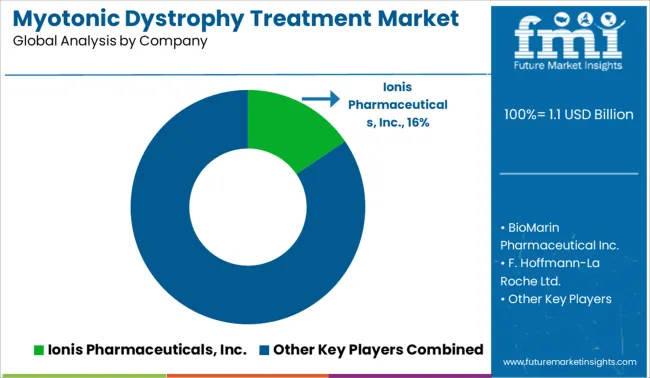
Prominent players in the Myotonic Dystrophy Treatment Market are Pfizer, Inc., Eli Lilly and Company, Mylan Pharmaceuticals Inc., Wockhardt Ltd., Teva Pharmaceutical Industries Ltd., Novartis AG, BioMarin Pharmaceutical, Inc., Asklepios Kliniken GmbH, Hoveround Corporation, and Siemens Healthcare, among others.
Recent Developments:
| Report Attribute | Details |
|---|---|
| Growth Rate | CAGR of 12.3% from 2025 to 2035 |
| Market Value in 2025 | USD 1.1 billion |
| Market Value in 2035 | USD 3.5 billion |
| Base Year for Estimation | 2025 |
| Historical Data | 2020 to 2025 |
| Forecast Period | 2025 to 2035 |
| Quantitative Units | Revenue in USD Million and CAGR from 2025 to 2035 |
| Report Coverage | Revenue Forecast, Company Ranking, Competitive Landscape, Growth Factors, Trends, and Pricing Analysis |
| Segments Covered | Therapeutics Class, Distribution Channel, Region |
| Regions Covered | North America; Europe; Asia Pacific; Latin America; Middle East & Africa (MEA) |
| Key Countries Profiled | The USA, Canada, Brazil, Mexico, Germany, The UK, France, Spain, Italy, China, Japan, South Korea, Malaysia, Singapore, Australia, New Zealand, GCC, South Africa, Israel |
| Key Companies Profiled | Pfizer, Inc.; Eli Lilly and Company; Mylan Pharmaceuticals Inc.; Wockhardt Ltd.; Teva Pharmaceutical Industries Ltd.; Novartis AG; BioMarin Pharmaceutical, Inc.; Asklepios Kliniken GmbH; Hoveround Corporation; Siemens Healthcare; Lupin; ANI Pharmaceuticals; Sun Pharma; Mallinckrodt; F. Hoffmann-La Roche Ltd.; Genzyme Corporation; Isis Pharmaceuticals, Inc.; Marina Biotech, Inc.; Valentia Biopharma S.L |
The global myotonic dystrophy treatment market is estimated to be valued at USD 1.1 billion in 2025.
The market size for the myotonic dystrophy treatment market is projected to reach USD 3.5 billion by 2035.
The myotonic dystrophy treatment market is expected to grow at a 12.3% CAGR between 2025 and 2035.
The key product types in myotonic dystrophy treatment market are molecular-based therapies and steroid therapy.
In terms of distribution channel, hospital pharmacies segment to command 47.8% share in the myotonic dystrophy treatment market in 2025.






Our Research Products

The "Full Research Suite" delivers actionable market intel, deep dives on markets or technologies, so clients act faster, cut risk, and unlock growth.

The Leaderboard benchmarks and ranks top vendors, classifying them as Established Leaders, Leading Challengers, or Disruptors & Challengers.

Locates where complements amplify value and substitutes erode it, forecasting net impact by horizon

We deliver granular, decision-grade intel: market sizing, 5-year forecasts, pricing, adoption, usage, revenue, and operational KPIs—plus competitor tracking, regulation, and value chains—across 60 countries broadly.

Spot the shifts before they hit your P&L. We track inflection points, adoption curves, pricing moves, and ecosystem plays to show where demand is heading, why it is changing, and what to do next across high-growth markets and disruptive tech

Real-time reads of user behavior. We track shifting priorities, perceptions of today’s and next-gen services, and provider experience, then pace how fast tech moves from trial to adoption, blending buyer, consumer, and channel inputs with social signals (#WhySwitch, #UX).

Partner with our analyst team to build a custom report designed around your business priorities. From analysing market trends to assessing competitors or crafting bespoke datasets, we tailor insights to your needs.
Supplier Intelligence
Discovery & Profiling
Capacity & Footprint
Performance & Risk
Compliance & Governance
Commercial Readiness
Who Supplies Whom
Scorecards & Shortlists
Playbooks & Docs
Category Intelligence
Definition & Scope
Demand & Use Cases
Cost Drivers
Market Structure
Supply Chain Map
Trade & Policy
Operating Norms
Deliverables
Buyer Intelligence
Account Basics
Spend & Scope
Procurement Model
Vendor Requirements
Terms & Policies
Entry Strategy
Pain Points & Triggers
Outputs
Pricing Analysis
Benchmarks
Trends
Should-Cost
Indexation
Landed Cost
Commercial Terms
Deliverables
Brand Analysis
Positioning & Value Prop
Share & Presence
Customer Evidence
Go-to-Market
Digital & Reputation
Compliance & Trust
KPIs & Gaps
Outputs
Full Research Suite comprises of:
Market outlook & trends analysis
Interviews & case studies
Strategic recommendations
Vendor profiles & capabilities analysis
5-year forecasts
8 regions and 60+ country-level data splits
Market segment data splits
12 months of continuous data updates
DELIVERED AS:
PDF EXCEL ONLINE
Fuchs Endothelial Corneal Dystrophy (FECD) Market Size and Share Forecast Outlook 2025 to 2035
Treatment-Resistant Hypertension Management Market Size and Share Forecast Outlook 2025 to 2035
Treatment-Resistant Depression Treatment Market Size and Share Forecast Outlook 2025 to 2035
Treatment Pumps Market Insights Growth & Demand Forecast 2025 to 2035
Pretreatment Coatings Market Size and Share Forecast Outlook 2025 to 2035
Air Treatment Ozone Generator Market Size and Share Forecast Outlook 2025 to 2035
CNS Treatment and Therapy Market Insights - Trends & Growth Forecast 2025 to 2035
Seed Treatment Materials Market Size and Share Forecast Outlook 2025 to 2035
Acne Treatment Solutions Market Size and Share Forecast Outlook 2025 to 2035
Scar Treatment Market Overview - Growth & Demand Forecast 2025 to 2035
Soil Treatment Chemicals Market
Water Treatment System Market Size and Share Forecast Outlook 2025 to 2035
Water Treatment Chemical Market Size and Share Forecast Outlook 2025 to 2035
Algae Treatment Chemical Market Forecast and Outlook 2025 to 2035
Water Treatment Market Size and Share Forecast Outlook 2025 to 2035
Water Treatment Ozone Generator Market Size and Share Forecast Outlook 2025 to 2035
Water Treatment Equipment Market Size and Share Forecast Outlook 2025 to 2035
Burns Treatment Market Overview – Growth, Demand & Forecast 2025 to 2035
CRBSI Treatment Market Insights - Growth, Trends & Forecast 2025 to 2035
Water Treatment Polymers Market Growth & Demand 2025 to 2035

Thank you!
You will receive an email from our Business Development Manager. Please be sure to check your SPAM/JUNK folder too.
Chat With
MaRIA